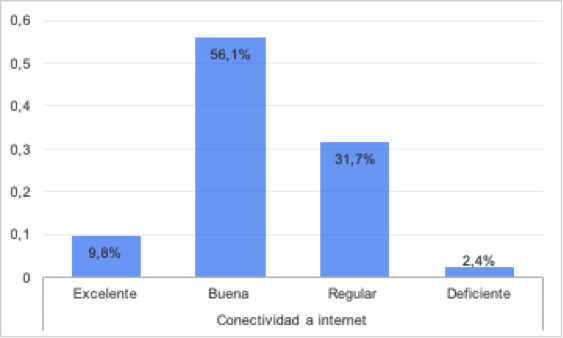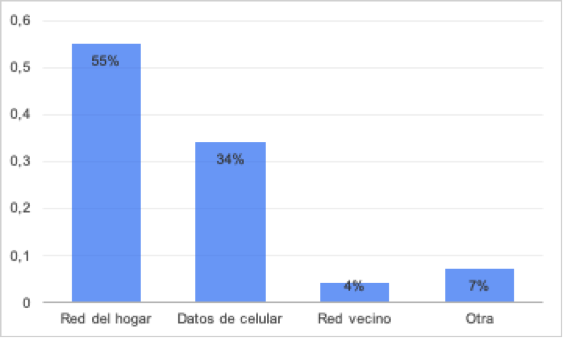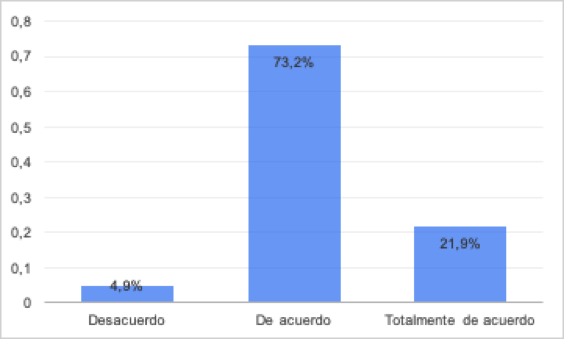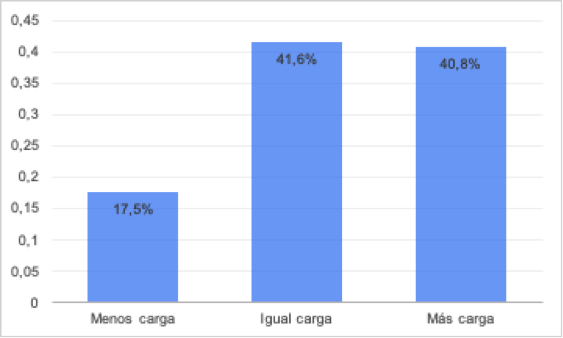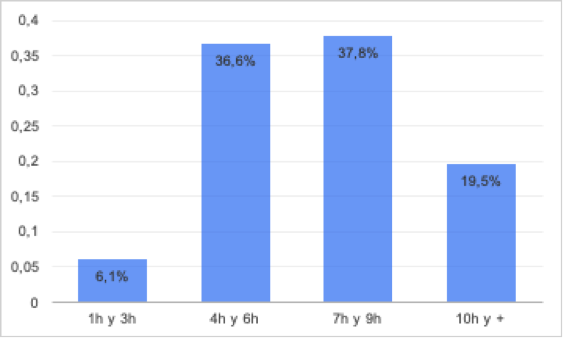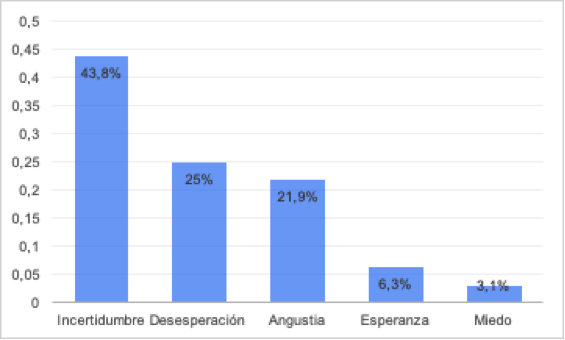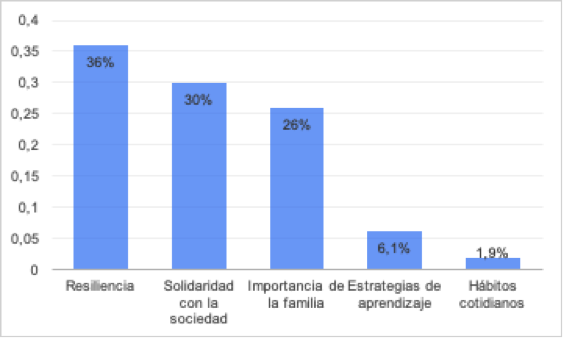Serviços Personalizados
Journal
Artigo
Indicadores
-
 Citado por SciELO
Citado por SciELO -
 Acessos
Acessos
Links relacionados
-
 Citado por Google
Citado por Google -
 Similares em
SciELO
Similares em
SciELO -
 Similares em Google
Similares em Google
Compartilhar
Universitas Medica
versão impressa ISSN 0041-9095versão On-line ISSN 2011-0839
Univ. Med. vol.61 no.4 Bogotá out./dez. 2020 Epub 30-Set-2020
https://doi.org/10.11144/javeriana.umed61-4.pemp
Original
Perception of the Second Semester Students of the Medical Career at the Pontificia Universidad Javeriana - Cali before the Transition from a Face-to-Face Modality to One Supported by Digital Media during the Time of the COVID-19 Pandemic
1Docente investigadora, Departamento de Ciencias Básicas de la Salud, Facultad de Ciencias de la Salud, Pontificia Universidad Javeriana, Cali
2Docente investigadora, Departamento de Ciencias Básicas de la Salud, Facultad de Ciencias de la Salud Pontificia Universidad Javeriana, Cali, Magíster en Ciencias Biomédicas.
3Institución Universitaria Escuela Nacional del Deporte. Docente investigador y director del grupo de investigación Educar 2030.
The current conditions resulting from the COVID-19 pandemic have limited the development of traditional education, considerably increasing the use of technological platforms, leading current education to a methodology supported by digital media. The objective of the study allowed to describe the perception of the students of the II semester of medicine at the Pontificia Universidad Javeriana (Cali) on the transition from a face-to-face modality to one supported by digital media during the time of the pandemic. The methodology was oriented from a mixed approach, where the descriptive design and a comprehensive design were articulated, built from quantitative and qualitative data processed in the SPSS Statistics and Nvivo programs. A questionnaire was conducted with 82 students through which the perception regarding the difficulties, opportunities and feelings that the learning supported by digital media has left them was identified. The COVID-19 pandemic left a social challenge for humanity. At the educational level, it marked a watershed, it modified all educational processes, not only from teaching but also from learning, modifying academic spaces, learning rhythms, study times, leading education to reinvent and empower new educational experiences.
Keywords COVID-19; education; medicine; perception
Las condiciones producto de la pandemia por COVID-19 han limitado el desarrollo de la educación tradicional y aumentado considerablemente el uso de plataformas tecnológicas. El objetivo del estudio fue describir la percepción de los estudiantes de segundo semestre de Medicina de la Pontificia Universidad Javeriana (Cali) sobre la transición de una modalidad presencial a una apoyada en medios digitales durante el tiempo de la pandemia. La metodología se orientó desde un enfoque mixto, donde se articuló el diseño descriptivo y un diseño comprensivo, construido a partir de datos cuantitativos y cualitativos procesados en los programas SPSS Statics y Nvivo. Con un cuestionario a 82 estudiantes, se identificó la percepción en cuanto a dificultades, oportunidades y sentimientos que les ha dejado el aprendizaje apoyado en medios digitales. La COVID-19 ha dejado un reto social para la humanidad. En lo educativo marcó un antes y un después, pues modificó todos los procesos educativos, no solo desde la enseñanza, sino desde el aprendizaje, al modificar los espacios académicos, ritmos de aprendizaje y tiempos de estudio y al llevar la educación a la reinvención y potencialización de nuevas experiencias educativas.
Palabras clave COVID-19; educación; medicina; percepción
Introduction
Higher education in Colombia is regulated by Law 30 of 1992, which must guarantee university autonomy and ensure the quality of educational services, allowing the full development of students and their academic and professional training (1). In this way, the institutions have been organizing their academic calendars to develop their face-to-face university programs. These were affected from the 2020-I period with the declaration of the World Health Organization (WHO) on the global health emergency and the confinement measures decreed in the country due to the new coronavirus initially reported in Wuhan (China).
From a set of cases of pneumonia with unknown etiology reported on December 31, 2019 in Wuhan, capital of Hubei Province in China, and which were associated with common exposure in seafood and live animal markets, it was identified that the causal agent of the outbreak corresponded to an unknown type of virus of the Coronaviridae family, which designates all its species under the term coronavirus. This zoonotic virus mainly affects the cells of the respiratory and digestive tracts (2,3). The WHO called it SARS-CoV-2, because it has a structure similar to that of the SARS-CoV virus, identified in Asia after the outbreak of severe acute respiratory syndrome in 2003 (4,5).
Its infection is known as COVID-19, and according to available data, its mortality rate is over 3.4% (6). On January 7, 2020, the WHO declared the outbreak an international public health emergency because of its rapid expansion. The WHO also established a comprehensive set of technical guidelines for all countries, based on experience with existing respiratory viruses, to detect cases, perform laboratory tests, and manage potential infections. As of January 30, a rate of 7,818 confirmed cases was reported worldwide, mainly concentrated in China, and it affected 18 countries (7).
On February 26, Latin America faced its first case of contagion from Brazil, and on March 6 the Ministry of Health and Social Protection reported the first case in Colombia. Five days later, with 125,000 cases of infection in 118 countries and without an effective treatment or vaccine, the WHO determined that the COVID-19 outbreak was a pandemic and urged countries to take urgent action to control the source of infection and achieve an early diagnosis (5,8). In Colombia, Resolution 385 of March 12 declared a health emergency, under which social isolation and quarantine measures were established. Likewise, government authorities were forced to prohibit mass events and to order the adoption of sanitary control measures in public and private establishments (9).
Several higher education institutions complied with the national regulations issued on March 12, which were extended until May 30, 2020, through a statement of the Ministry of Education, the State University System, the Colombian Association of Universities and the Network of Technical, Technological and University Institutions on the contingency generated by COVID-19, which established the containment of the spread of the virus, guaranteeing the provision of educational services through the implementation of different available pedagogical strategies. Thus, face-to-face classes were cancelled, the need to set up health surveillance systems in academic communities for the early detection of people with respiratory symptoms was established, and virtual academic activities were strengthened in order to guarantee the continuity of the contents established for 2020-1 (10).
This is how the Pontificia Universidad Javeriana, Cali branch, announced a series of institutional actions. In principle, the temporary suspension of academic activities between March 16 and 23 was announced, with the aim of preparing the migration of face-to-face subjects to the remote modality. Later, strategies were announced to accompany teachers in the planning and development of the subjects in this modality, through weekly courses on the handling of digital tools. Actions were also taken on behalf of students, such as lending them computers and providing financial relief to give continuity to academic activities (11); this in order to play an essential role in supporting students and responding to their health, education and safety needs, as well as contributing to the reduction of anxiety, maintaining an academic routine beneficial to their mental health and providing them with the capacity for long-term psychological recovery and adaptation (12). Finally, these decisions were articulated with the confinement measures decreed by the national Government from March 24 to April 13, 2020, due to the number of infections in the country, which quickly rose to 158.
The second semester students of Medicine of the Faculty of Health studied three subjects of the basic nucleus (Nervous System, Locomotive System and Cardiorespiratory System), characterized by being modular, that is, distributed sequentially with a specific number of weeks in the semester. In the case of the Locomotive System, the course has an intensity of 10 hours per week, during four weeks. At the time the classes were suspended, the students were finishing the first week, so the transition of the course towards digital education was experienced, respecting the schedules established in the face-to-face modality, under the digital modality, with synchronous meetings.
For the development of the Locomotive System by virtual means (supported by digital media) learning guides were designed that allowed the revision of the topics before the synchronous meetings established through the Blackboard platform. These guides indicated the objective, the resources to be used (such as e-books, digital atlases or interactive anatomy platforms). An explanatory video on the subject was also provided, as well as a logical sequence to approach the contents in an autonomous way, establishing the evaluation activity in each meeting. During the synchronous meeting, doubts about the activities set out in the guide and about the video were resolved, maintaining a constant two-way dialogue with the students.
The use of information and communication technologies was established as a priority action by UNESCO in 1998 (13). However, the arrival of the increasing effects of the COVID-19 pandemic in 2020, has forced teachers and students to quickly change the mechanics of their educational activities and begin using various digital tools to accomplish the teaching-learning process that had begun in the classrooms. However, this rapid transition managed to demonstrate that more than twenty years were insufficient to adapt the general population to 100% technological environments, since in this new modality away from the face-to-face education, the education actors have faced various difficulties, whether of motivational origin, such as time management and self-care, technical, technological or financial difficulties (14), and the concern about the risk of contagion, as young people are possible asymptomatic carriers. Added to this are the difficulties arising from travel and confinement, which can lead to acute stress and affect the academic performance of our future doctors (12) at this time, when their training is a major need in a global emergency context (15).
The learning strategies implemented from the Locomotive System course focused their processes on teaching students to learn; students are encouraged to reflect deeply on their experiences, building new and more complex meanings from the Ignatian vision (16). Teaching strategies are based on all the teacher’s actions, so they constitute a unique opportunity to renew the didactic strategies implemented, not only because of a strong implementation of technology, but because this introduction requires a constant reflection by teachers on what and how they want to teach their subject of the Locomotive System (17).
In this sense, the application of the Ignatian Pedagogical Paradigm (IPP) puts into play the capacity of the educational community to carry out its daily life with all its complexities and consequences, a hallmark of the Ignatian vision. Thus, the transition from a face-to-face mode to one based on digital media brings into play the entire pedagogical proposal of the Society of Jesus (17).
The IPP teaches to see reality from the person’s social and personal context. It does not seek isolated knowledge, but rather focuses the person on their life process, integrating the experience as the center of their learning process. The feelings, motivations and interests of the person are articulated, and thus, through reflection, it teaches to think and critically analyze reality. The IPP seeks action committed to the transformation of the realities of the world, where learning is put into play based on personal and social transformations. Finally, in the IPP evaluation is conceived as a search for results: the person is taught to do the right things and well done from the beginning (18).
Taking into account the above, the challenge was aimed at pedagogical innovation as a fundamental strategy to give continuity to academic activities (15,19), implementing new methodological tools and maintaining student motivation. For this, it is essential that teachers know the first impression or knowledge generated in them as a result of the current situation, about their socio-demographic conditions, connectivity situations, appreciations of the teaching-learning process and feelings generated in this situation. In this way, the objective of this research was to describe the perception of the second semester students of Medicine at the Pontificia Universidad Javeriana (Cali branch) about the transition from a face-to-face modality to one supported by digital media during the time of the COVID-19 pandemic.
Materials and methods
The study had a mixed approach, oriented from the descriptive cross-sectional design. This allowed to identify the students’ perceptions in relation to teaching and learning strategies, and from a comprehensive design of an introspective experiential cut to understand the predominant feelings during the time of mandatory confinement. This study was carried out in the months of March and April 2020 during the development and completion of the Locomotive System course. It had a non-probabilistic sample, taken for convenience, and on a voluntary basis. The study population was made up of 108 students enrolled in the Locomotive System subject in the second semester of medicine at the Pontificia Universidad Javeriana (Cali branch) in the period 2020-1.
To develop the article, 82 students of both sexes from three groups G, S and W were taken as a sample, who agreed to participate in the study voluntarily. For this purpose, they answered the questionnaire and were given a semi-structured interview in order to identify their perception of the transition from a face-to-face mode to one supported by digital media. To do this, the authors of this article designed a questionnaire entitled Students' Perception of the Virtualization of the Locomotive System given the circumstances of the global COVID-19 pandemic. The questionnaire consists of 28 questions, which allowed identifying the students’ perception of this situation. The instrument was initially designed with socio-demographic data, technological resources, academic conditions and personal feelings. Of the total number of questions, twenty were considered, which met the objectives of the study. To measure the quantitative questions of the questionnaire, a Likert-type scale was used, which used the parameters Agree, Totally agree, Disagree and Totally disagree. In the validation and reliability of the questionnaire, a Cronbach alpha equal to 0.6046 was used, which is equivalent to good reliability.
The questionnaire was applied to all students through digital media (Google Forms) with a link sent to their e-mails. The questionnaire started with the informed consent, mentioned the purpose of the survey and that the data obtained would be used for academic or research purposes. It was also clarified that the questionnaire complies with the ethical principles of the Declaration of Helsinki, and that all information provided would be treated according to Law 1581 of 2010 on the confidentiality of data. They were informed that the data would be analyzed anonymously and that if the student agreed to participate voluntarily, they should authorize the management of the data and continue to complete the questionnaire. The data were tabulated using the statistical SPSS program, version 25, analyzed through descriptive statistics.
The semi-structured interview had guiding questions aimed at understanding the students’ perceptions of emerging feelings, significant learning during mandatory confinement, and the teaching and learning processes resulting from the COVID-19 pandemic. This information was analyzed with NVivo data analysis software.
The analysis followed the logic of open, axial and selective categorization, which allowed to reveal the final categories of analysis in relation to feelings and learning during this time. Each category of study contained a series of stories, which were analyzed following the logic of discourse analysis proposed by Wodak and Meyer (20) and Iñíguez-Rueva and Antaki (21), following the guidelines of Schutz (22), related to the understanding of the social world.
Results
The study was carried out with the students of the Locomotive System subject of the second semester of medicine of the Pontificia Universidad Javeriana (Cali branch), who were in an age range between 16 and 27 years. Fifty-seven percent of the population was female, and 43% male. The 16-19 year old group represented 82% of the population. At the end of the results the most important emerging feelings and the resulting categories associated with the significant learning that were found in the medical students are presented.
Students have an average of 2.7 at home. However, 5% do not own a computer for their academic activities (Table 1). About 21% have to share their computer with another member of the household; the study shows that they share the computer with at least 1.2 people.
Table 1. Use of computers (in percentages)
| Yes | No | |
| Own computer | 95 | 5 |
| Share the computer at home | 21 | 79 |
Ten percent of the students said they have an excellent internet connection; 32 percent said they have an unstable connection, and 2 percent considered it to be poor (Figure 1).
In this sense, about 34% of the students have difficulties accessing the internet and must resort to different strategies to stay connected during the synchronous classes. To do this, some use cell phone data, others use the solidarity of their neighbors, and still others even use the places where internet services are provided. Figure 2 shows the difficulties related to connectivity.
Within the teaching strategies, it was possible to identify that the previous readings and the workshops have a great acceptance in the face of the students’ learning processes. Only a small group of students consider that they do not contribute significantly to the learning process. More than half of the students totally agree with the time devoted to accompaniment by teachers in the learning process, while 11% consider it insufficient (Table 2).
Table 2. Perception of teaching strategies used by teachers (in percentages)
| Disagree | Agree | Totally agree | |
| Do you consider that the pre-class reading guides are a necessary support to develop the topics? | 1.2 | 39.0 | 59.8 |
| Do you consider that the previous workshops and their review contribute to your learning process? | 1.2 | 36.6 | 62.2 |
| Do you consider that the synchronous meetings are an indispensable space to reach your learning objectives in the locomotive system? | 7.3 | 32.9 | 59.8 |
| Do you think that the time dedicated by your teachers in this system was enough to feel accompanied in the process? | 11.0 | 37.8 | 51.2 |
Ninety-five percent of the students considered that the learning objectives in the Locomotive System course were finally met, as shown in Figure 3.
During this time of pandemic, students feel that they have more distractions at home than at the university. Also, 62% say they spend enough time studying at home, while 38% feel it is not enough. They also say that education supported by digital media did not take away from the rigor of their learning process. They also consider that their learning has been significant during the time of the pandemic (Table 3).
Table 3. Perception of student learning (in percentages)
| Yes | No | |
| Do you think that virtual learning has taken away from the rigor of your learning process in the system? | 91.5 | 8.5 |
| Do you think your learning has been significant during the COVID-19 pandemic? | 63.4 | 36.6 |
| Do you think you have spent enough time studying at home? | 62.2 | 37.8 |
| Do you feel that you have more distractions at home than at the university? | 96.3 | 3.7 |
Despite the fact that students have had to move from the face-to-face mode to the modality supported by digital media, 82.4% of them state that academic rigor has remained the same or has increased, as shown in Figure 4.
In addition, 38% of the medical students reported that during the time of the pandemic they had an average of 7-9 hours of work at home per day, while 19% reported that they were studying more than 10 hours per day on average to meet the course objectives (Figure 5).
Figure 6 shows the most emerging feelings among medical students regarding the COVID-19 pandemic.
Clearly, the feeling called uncertainty is the one that has the most social force among medical students, while hope and fear have the least social force among them. In addition, they stated that the significant learning they have obtained during the pandemic can be related to the daily actions of life, reflected in the ability to overcome difficulties, understanding the various situations that have occurred as the possibility of recreating themselves from within (Figure 7).
Discussion
The conditions of the pandemic have limited the development of traditional education. For this reason, the use of electronic devices and virtual platforms increased considerably in response to teaching, learning and communication needs, stimulating distance learning experiences for medical and health science students (23) and creating a need for researchers and teachers to evaluate the methods used for virtual learning and thus use them as an alternative or complementary method in teaching (24).
It is important to recognize the effort of the university and the medical students to give continuity to the classes and achieve the objectives set in the system under these circumstances of mandatory confinement associated to the COVID-19 pandemic, where the face-to-face methodology was suddenly modified to one supported by digital media and synchronous in most of its courses. This is a first victory for those of us who understand education as a human right (25).
The university offered technology and connectivity support for students who needed it. Not everyone took advantage of this measure and assumed the challenge with the technological tools they had, perhaps imagining that the situation would not last long. There were problems with the technological tools in about 21% of the students, who share the computer with another member of the family. This made synchronous meetings difficult for them, as they depended on no other family member using the computer at the same time. In addition, it was found that 5% do not have their own computer and remain under the same disposition.
The results of this study are similar to those obtained by Link and Marz (25) in 2006 at the Medical University of Vienna, whose methodology is mostly online. They surveyed medical students regarding the technological infrastructure that they had and found that 74% had their own computer, 20% shared it with a family member or roommate, and 5% depended on the university computers. It is worth noting that these results date back fourteen years.
In addition to the difficulties presented by the computers and their availability of use, there were internet connection problems: about 34% of the students reported having had connection difficulties. This is a variable that is worth taking into account for the full achievement of objectives in subjects supported by digital media and for the students’ learning processes, as mentioned by Victoria Gagliardi in her article “Educational challenges in times of pandemic” (26). She indicates that “a population that has problems with Internet access or that does not have a personal computer will have problems for synchronous connection” (26). Difficulties with connectivity or internet access may be associated with the territorial location: many of the students moved to their rural or urban places of origin or, perhaps, where they live the internet coverage is unstable, or even not available at all. Conditions like these begin to generate inequality in students, and were further accentuated by the modification of methodology through digital media in times of the COVID-19 pandemic (27).
It could be seen that 55% of the students had their own network at home; while 34% solved their connectivity problems with cell phone data. This mode of internet access is slow and prevents the use of synchronous tools that involve a connection that lasts a long time (25).
In Colombia, education based on digital media still presents multiple gaps in access to the digital world (26) that may depend on technological tools such as connectivity, computers, signal or coverage depending on the location, the type of internet the person has, or even those associated with the adaptation process by teachers in the transformation of methodologies, the search for alternatives or tools to continue teaching without physical presence, generating the least possible trauma for students.
In this study we wanted to take into account the student’s perception of the strategies or tools used by their teachers during the system under this methodology supported by digital media. We found that 59.8% of the students fully agree that pre-class reading guides support the development of the topics; likewise, 62.2 % highlighted the importance of holding previous workshops (activities that were proposed and planned at the time of learning about the measures established by the Presidency of the Republic, which led to reinventing face-to-face education to mobilize through digital media). This generated a great commitment and challenge on the part of the university’s directors and professors to maintain the academic rigor under a “new” methodology for this type of course in the medical career. Hence, it is recommended that teaching activities be structured and thought out in the social context and adapted according to both technological conditions and the digital technical skills of the educational subjects and their ability to reinvent themselves in this process (26).
In the study by Habibzadeh et al. (24) in 2019, positive results were obtained from nursing students regarding technology-mediated education vs. traditional education, considering that even though both methods had increased knowledge, the use of social networks and virtual tools had a greater impact, because they improved academic performance. They also indicated that the virtual teaching method has several advantages, such as flexibility, absence of time and space limitations, coverage of a large number of students, accessibility and multimedia appeal, which have become one of the methods preferred by students.
Although it could be understood that in this “virtual” modality expressed by the author, no precise study times were established, our teaching method was based on the digitalization of education, that is, on the use of technological means in the established class times. This could explain that 96.3% of the respondents had more distractions for learning from home, which generated in 37.8% the perception of insufficient time to study the contents and an increase in the academic load in 40.8% of the cases.
Ellaway and Masters (28) consider that the integration of digital resources in pedagogy facilitates flexible and student-centered teaching scenarios by encouraging interaction and allowing asynchronous communication. It is possible that, according to these characteristics, learning supported by digital media has been rated as significant in 63.4% of medical students, and this positive response is reflected in previous studies, in which 96% considered that learning is valuable (29).
Choules (30) agrees that the appropriate use of digital tools becomes a fundamental strategy for teachers, not only because it is possible to reuse the content in various environments, but also because it allows the combination of different learning modalities, such as didactic teaching, self-learning, collaborative learning and e-learning to develop skills and achieve the learning objectives of students, as evidenced by our results: 95% of the population indicated that these were met. He also recognizes the development of diagnostic reasoning and patient management skills through interactivity, effective for professional development through decision making and critical thinking by medical students (31).
The success of this digital modality and the attitudes towards the teaching-learning process depend largely on the type of student being approached. More acceptance has been found among independent and autonomous students, without forgetting that there are influencing factors such as learning needs, student preferences, and educational orientations (32). One of the results that most draws attention to the perception of medical students is that 91% of them consider that their learning has lost rigor with the implementation of this new modality. Another factor to consider in the students’ perception is the intensity of computer use and previous experience and the quality of use in virtual educational methods. For this reason, e-learning planning and support measures are essential to diminish these difficulties (25).
According to the respondents, the time dedicated to training in Medicine ranges between 3 and 6 hours and 6 and 9 hours per day in 37% and 38%, respectively, and 19% require more than 9 hours to meet their learning needs. It is worth mentioning that the university established synchronous meetings respecting the subject schedules. Medicine is a career that, on average, requires 8 hours of face-to-face learning a day, and as evidenced in the survey, 75% of students only meet that schedule and do not spend extra hours studying to maintain rigor in the learning process.
For their part, teachers should identify and manage additional measures to prevent students who are less skilled in the use of computer tools and strategies from being widely affected or developing negative attitudes or rejection of digital learning (25,33). By the time this situation ends, the education system will have to have reinvented and potentiated itself towards new forms of distance professional education experiences (23).
This is how the COVID-19 pandemic has generated a feeling of uncertainty in students and the community that disturbs students not only with their academic processes but also with the processes involving the family and life itself in times of mandatory confinement. Heidenberg explained the uncertainty as the result of an “uncertain” character; he also associated it with some “disturbance” (quoted in 34). Initially, the results of the uncertainty principle were associated to quantum physics studies; in time, eventually, to biological processes, anatomy and social studies, including poetry (35 - 38 ).
However, uncertainty, fear, anguish, and despair, as feelings, have emerged in life processes with their specific peculiarities in this time of pandemic, when students are forced to share more time with the family, comply with the academic activities, and organize time for study and personal activities. These perceptions are evidenced through their stories, in which one of the students stated: “You have to take advantage of the moments. And always be prepared for what is coming, not stop growing and continue to believe that we can get ahead" (story 1).1 The great challenges in the era of the coronavirus, related to academic processes and to the risks of contagion, have generated some perplexity among students. The new academic challenges imply, according to Pérez-Gómez (39), a new pedagogical culture and a new professional to face the new challenges.
In this respect, students must reorganize their daily routines and habits: time management, study habits and new technological skills, to face the challenges of this emerging education model supported by digital media. In this sense, all the transformations that take place affect not only the teaching processes, but also the learning processes, being aware of the new challenges that both students and teachers must take on in this era of the coronavirus: “We need to improve community use of ICTs. In spite of the difficulties presented by this new pandemic, I have been able to notice the anguish of my teachers to teach in the best way” (story 11). Students are those who, through the changes in their daily life and in their university career, have that positive and hopeful attitude towards life: “Having a positive attitude in the face of difficult situations is the best way to face problems” (story 16).
This time of pandemic has allowed higher education institutions to update their information technology resources; at the same time, students have updated their skills in the use of different technological tools in a short period of time (40,41). Digital platforms have become a fundamental teaching tool for medical education. Pérez-Pérez et al. (42) state that a large number of teachers and students take advantage of them to improve both teaching and learning processes, in such a way that independent work is strengthened. However, students have not only become familiar with the new platforms and break with traditional education schemes, but they have also managed to demonstrate significant learning related to resilience, the importance of family at this time, among which stand out: “The family is the most important thing we have and they support us in the most difficult moments... With this experience I have been able to spend more time with my parents and my brother” (story 3). Likewise, solidarity with society towards the most vulnerable people is highlighted when they express: “We must be more aware of what is happening in our current context, taking responsibility and abiding by the rules. In addition, we must help as much as possible the people affected by the pandemic” (story 5).
The medical students of the Pontificia Universidad Javeriana are impregnated by the MAGIS Ignatian seal: “To be more in order to serve better”, by being aware not only of the needs that occur inside the classroom, but having the ability to go out of themselves in building a better society: “We must rethink the way we human beings live, how we act, how we treat others. People are not missing material things, but being able to share with our families and friends” (story 7).
To conclude, it can be understood that the perceptions of the medical students in relation to the situation of the pandemic not only modified their study habits, the time they dedicate to their professional career or their daily routine, but also allowed them to understand how vulnerable they can become in the face of this global pandemic situation, which brought them closer to their families and aroused a feeling of solidarity with the poorest and most vulnerable people.
Conclusions
In Colombia, digital-based education still presents multiple technical and technological difficulties, which were evidenced and exacerbated during the conditions of social isolation due to the health emergency derived from COVID-19.
The difficulties associated with the conditions of the home represent a complex scenario for organizing academic activities, because the times allocated to study are affected, which are increased by the distractions that studying at home represents, since in many cases there are no ideal conditions for education.
The COVID-19 pandemic posed a social challenge to humanity. In the educational field, it marked a turning point in all processes, not only from teaching, but from learning, by modifying academic spaces, learning rhythms, study times or the teacher-student and student-student interactions. This significantly affected their perceptions of their work and academic load in terms of rigor, family and their sense of solidarity with the neediest in society.
Referencias
1. Ley 30/1992 del 28 de diciembre, por el cual se organiza el servicio público de Educación Superior [capítulo 1]. Diario Oficial n.º 40.700, de 29-12-1992 [internet]. Disponible en: https://www.cna.gov.co/1741/articles-186370_ley_3092.pdf [ Links ]
2. Chen Y, Liu Q, Guo D. Emerging coronaviruses: genome structure, replication, and pathogenesis. J Med Virol. 2020;92(4):418-23. http://doi.org/10.1002/jmv.25681 [ Links ]
3. Han Q, Lin Q, Jin S, You L. Recent insights into 2019-nCoV: a brief but comprehensive review. J Infect. 2020;80(4):373-7. https://doi.org/10.1016/j.jinf.2020.02.010 [ Links ]
4. Lai CC, Shih TP, Ko WC, Tang HJ, Hsueh PR. Severe acute respiratory syndrome coronavirus 2 (SARS-CoV-2) and coronavirus disease-2019 (COVID-19): the epidemic and the challenges. Int J Antimicrob Agents. 2020;55(3):105924. https://doi.org/10.1016/j.ijantimicag.2020.105924 [ Links ]
5. Consejo General de Colegios Farmacéuticos. Coronavirus: COVID-19 [internet]. Madrid; 2020. Disponible en: https://www.portalfarma.com/Profesionales/campanaspf/Asesoramiento-salud-publica/infeccion-coronavirus-2019-nCoV/Documents/Informe-tecnico-Coronavirus.pdf [ Links ]
6. Álvarez ML, Revuelta JR, Portero BO, Méndez CP, Montero GS, Alfonso AL. Mortalidad por Covid-19 en pacientes con cáncer en un hospital de Madrid durante las primeras 3 semanas de epidemia. Med Clin. 2020. https://doi.org/10.1016/j.medcli.2020.05.005 [ Links ]
7. Organización Mundial de la Salud. COVID-19: cronología de la actuación de la OMS [internet]. [Citado 2020 may 18]. Disponible en: https://www.who.int/es/news-room/detail/27-04-2020-who-timeline---covid-19 [ Links ]
8. Trilla A. Un mundo, una salud: la epidemia por el nuevo coronavirus COVID-19. Med Clin. 2020;154(5):175-7. https://doi.org/10.1016/j.medcli.2020.02.002 [ Links ]
9. Resolución 385/2020 del 12 de marzo, por la cual se declara la emergencia sanitaria por causa del coronavirus COVID-19 y se adoptan medidas para hacer frente al virus [internet]. Ministerio de Salud y Protección Social. Disponible en: https://www.minsalud.gov.co/sites/rid/Lists/BibliotecaDigital/RIDE/DE/DIJ/resolucion-385-de-2020.pdf [ Links ]
10. Ministerio de Educación. Comunicado del Ministerio de Educación, el Sistema Universitario Estatal-SUE, la Asociación Colombiana de Universidades-ASCUN, y la Red de Instituciones Técnicas, Tecnológicas y Universitarias-REDTTU sobre la contingencia generada por el COVID-19 [internet]. 2020 mar 12. Disponible en: https://www.mineducacion.gov.co/1759/w3-article-393856.html?_noredirect=1 [ Links ]
11. Pontificia Universidad Javeriana de Cali. Listado de comunicados-Covid-19 [internet]. [Citado 2020 may 22]. Disponible en: https://www.javerianacali.edu.co/acciones-covid-19/comunicados [ Links ]
12. Ferrel MN, Ryan JJ. El impacto de COVID-19 en la educación médica. Cureus. 2020;12(3):e7492. https://doi.org/10.7759/cureus.7492 [ Links ]
13. Vidal M, Cañizares O, Sarasa N, Santana A. Las nuevas tecnologías en la enseñanza y el aprendizaje de la Anatomía Humana. Educ Médica Super [internet]. 2004;18(4):1-1. Disponible en: http://scielo.sld.cu/scielo.php?script=sci_arttext&pid=S0864-21412004000400010&lng=es [ Links ]
14. Zhai Y, Du X. Addressing collegiate mental health amid COVID-19 pandemic. Psychiatry Res. 2020;288:113003. http://doi.org/10.1016/j.psychres.2020.113003 [ Links ]
15. Rose S. Medical student education in the time of COVID-19. JAMA. 2020;323(21):2131-2. http://doi.org/10.1001/jama.2020.5227 [ Links ]
16. Kolvenbach P-H. Educación y valores. Orientaciones Universitarias [internet]. 1991;(8):17-24. Disponible en: https://issuu.com/historicopuj/docs/8 [ Links ]
17. Posada CV. Propuesta educativa de la Compañía de Jesús. Asociación de Colegios Jesuitas de la Compañía de Jesús; 2005. [ Links ]
18. Brookfield SD. The skillful teacher. San Francisco: Jossey- Bass; 1990. [ Links ]
19. Moreno-Correa SM. La innovación educativa en los tiempos del Coronavirus. Salutem Scientia Spiritus [internet]. 2020;6(1):14-26 Disponible en: https://www.researchgate.net/publication/340515328_La_innovacion_educativa_en_los_tiempos_del_Coronavirus [ Links ]
20. Wodak R, Meyer M. Métodos de análisis crítico del discurso. Barcelona: Gedisa; 2003. [ Links ]
21. Íñiguez-Rueda L, Antaki Ch. El análisis del discurso en psicología social. Bol Psicol. 1994;(44):57-74. [ Links ]
22. Schutz A. La construcción significativa del mundo social: introducción a la sociología comprensiva. Barcelona: Paidós Ibérica; 1993. [ Links ]
23. Costa MJ, Carvalho-Filho M. Una nueva época para la educación médica después de la COVID-19. Rev Fundación Educ Méd. 2020;23(2):55. http://doi.org/10.33588/fem.232.1052 [ Links ]
24. Habibzadeh H, Rahmani A, Rahimi B, Rezai SA, Aghakhani N, Hosseinzadegan F. Comparative study of virtual and traditional teaching methods on the interpretation of cardiac dysrhythmia in nursing students. J Edu Health Promot. 2019;8:202 https://doi.org/10.4103/jehp.jehp_34_19 [ Links ]
25. Link TM, Marz R. Alfabetización informática y actitudes hacia el aprendizaje electrónico entre estudiantes de medicina de primer año. BMC Med Educ. 2006;6(1). http://doi.org/10.1186/1472-6920-6-34 [ Links ]
26. Gagliardi V. Desafíos educativos en tiempos de pandemia. Question/Cuestión. 2020;1(mayo):e312. http://doi.org/10.24215/16696581e312 [ Links ]
27. Quiroz-Reyes C. Pandemia Covid-19 e inequidad territorial: el agravamiento de las desigualdades educativas en Chile. Rev Inter Educ Justicia Soc [internet]. 2020;9(3). Disponible en: https://revistas.uam.es/riejs/article/view/12143/12022 [ Links ]
28. Ellaway R, Masters K. AMEE guide 32: e-learning in medical education part 1: learning, teaching and assessment. Med Teach. 2008;20:455-473. https://doi.org/10.1080/01421590802108331 [ Links ]
29. Khogali SEO, Davies DA, Donnan PT, Gray A, Harden RM, Mcdonald J, et al. Integration of e-learning resources into a medical school curriculum. MedTea Teach. 2011;33(4)311-8. https://doi.org/10.3109/0142159X.2011.540270 [ Links ]
30. Choules AP. The use of elearning in medical education: a review of the current situation. Postgrad Med J. 2007;83:212-6. https://doi.org/10.1136/pgmj.2006.054189 [ Links ]
31. Thakore H, McMahon T. An interactive e-tutorial in pathology. Med Educ. 2006;40:1135. https://doi.org/10.1111/j.1365-2929.2006.02576.x [ Links ]
32. Horiuchi S, Yaju Y, Koyo M, Sakyo Y, Nakayama K. Evaluation of a web-based graduate continuing nursing education program in Japan: a randomized controlled trial. Nurse Educ Today. 2009;29(2):140‐9. https://doi.org/10.1016/j.nedt.2008.08.009 [ Links ]
33. Loke Jennifer CF. Computer mediated conferencing - a hope or hype for healthcare education in higher learning?: a review of the literature. Nurse Educ Today. 2007;27(4):318‐24. https://doi.org/10.1016/j.nedt.2006.05.012 [ Links ]
34. Bohm D. La totalidad y el orden implicado. Ciudad de Méxic: Kairós, 1998. [ Links ]
35. Ramos MH. Incertidumbre en medicina. Revista de Postgrado de la VIa Cátedra de Medicina [internet]. 2007;(167). Disponible en: https://med.unne.edu.ar/revistas/revista168/11_168.htm [ Links ]
36. Giribet GE. Sobre el principio de incertidumbre de Heisenberg entre tiempo y energía: una nota didáctica. Rev Mex Fís E [internet]. 2005;51(1):23. Disponible en: https://rmf.smf.mx/pdf/rmf-e/51/1/51_1_23.pdf [ Links ]
37. Venegas JL. El “principio de incertidumbre” de Heisenberg y la narración intersticial de “Axolotl” de Julio Cortázar. Hisp J. 2007;28(2):81-95. Disponible en: https://www.jstor.org/stable/44284876. [ Links ]
38. Cortés-Riera LE. Werner Heisenberg: las conexiones entre la educación humanística, la ciencia de la naturaleza y la cultura occidental. Mayéutica Revista Científica de Humanidades y Artes [internet]. 2019;7(1):195-203. Disponible en: http://bdigital2.ula.ve:8080/xmlui/654321/1829 [ Links ]
39. Pérez-Gómez ÁI. Ser docente en tiempos de incertidumbre y perplejidad. Márgenes: Revista de Educación de la Universidad de Málaga. 2019:3-17. https://doi.org/10.24310/mgnmar.v0i0.6497 [ Links ]
40. González-Valencia H, Isaza-Gómez GD, Idarraga MA, Rodríguez-Villaquirán M. Integrating the virtual platform Memrise as a teaching tool for English vocabulary in foreign language students of second semester at a university. Rev Latinoam Estud Educ. 2020;16(1):259-84. https://doi.org/10.17151/rlee.2020.16.1.12 [ Links ]
41. Chaljub-Hasbún JM. La plataforma digital Seesaw: su integración en una clase dinámica. Píxel-Bit. Revista de Medios y Educación. 2019;54:107-24. http://dx.doi.org/10.12795/pixelbit.2019.i54.06 [ Links ]
42. Pérez-Pérez SM, Expósito-Gallardo MC, Ortiz-Romero GM, Castro Pérez M, Soto Santiesteban V, Mustelier de León RC. Utilización de la plataforma Moodle en la disciplina Informática Médica de la carrera de Medicina. Edumecentro [internet]. 2020;12(2):37-48. Disponible en: http://scielo.sld.cu/pdf/edu/v12n2/2077-2874-edu-12-02-37.pdf [ Links ]
Received: June 01, 2020; Accepted: July 01, 2020











 texto em
texto em 

